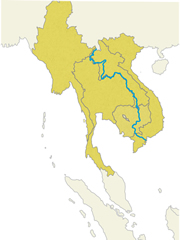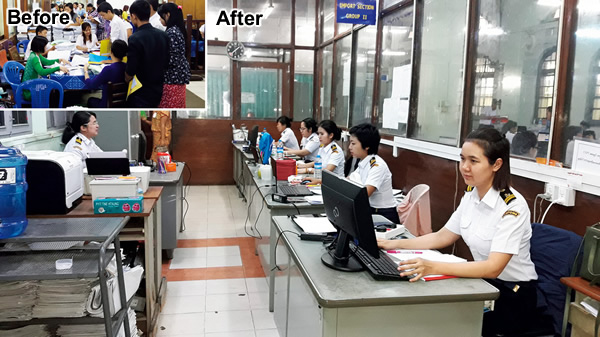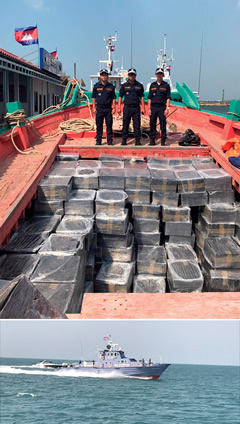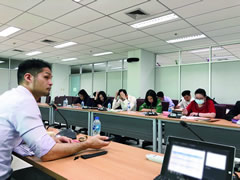If developing countries can facilitate trade, then their economies will grow and their people will prosper. Critical to maximizing the potential for trade is modern customs services to expedite the flow of people and goods and prevent smuggling.
It is standard practice for countries, including Japan, to have customs services to facilitate trade, ensure a safe and secure society, and collect duties and taxes appropriately and fairly. When seeking to expand the economy of an entire region, as is being done in the Mekong region, it is necessary to stimulate intra-regional trade; however, people and goods will not flow smoothly if the Customs administrations of the countries in the region differ greatly in structure, system, or capacity.

JICA works with Japan Customs to help build staff capacity and improve systems of Customs services in each country of the Mekong region according to their needs. To accelerate this process, Japan Customs personnel are dispatched to the Customs administrations of beneficiary countries in the region for technical assistance to facilitate the free and safe movement of people and goods.
Myanmar Customs

The Myanmar Automated Cargo Clearance System (MACCS) streamlined procedures and did away with the long lines of people and the mountains of documents at the customs office.
Now we can quickly process thousands of customs declarations.
Facilitating Trade and Enforcing Laws
Risk management is an important part of customs modernization. If the same amount of effort is exerted for inspecting each and every item for customs clearance, then people will line up at the airport, trucks will line up at the border, and the flow of goods will slow to a crawl. At the same time, Customs must stop goods that are likely to be smuggled to evade tax (illicit drugs, weapons, terrorism-related materials, counterfeit goods, etc.). To make things more difficult, the volume of goods handled by Customs is increasing year by year, while the number of customs officers remains limited.
In order to carry out Customs procedures efficiently in such circumstances, Custom's inspection must focus on high-risk items and process low-risk items as quickly as possible. Mr.Fukuzono Akihiko, who was dispatched by JICA to enhance such a system at Thai Customs, comments: "Import-export volumes are expected to increase in Thailand as development proceeds on the Eastern Economic Corridor (EEC), and on logistics infrastructure like the Laem Chabang Port.Thai Customs is not allowed to increase personnel to deal with this, thus a higher level of implementation of risk management is required. The challenges that they face are introducing more efficient risk assessment procedures, improving intelligence analysis, capacity and applying the risk management approach in a structured and systematic manner." Enhancement of risk management capability has become a common issue for the Mekong countries to achieve both trade facilitation and law enforcement as trade volumes increase.
Introduction of Japanese Automated Cargo Clearance Systems
In Vietnam and Myanmar, JICA has supported the introduction of automated cargo clearance systems based on the Nippon Automated Cargo and Port Consolidated System (NACCS) of Japan. JICA also provided comprehensive support to help these countries restructure their Customs clearance processes and build the capacity of personnel to use the new systems. Vietnam adopted the system in 2014 and now uses it to process 99 percent of its import and export declarations. Myanmar introduced the system in 2016 in Yangon and Thilawa, and has been implementing it since 2018 in Myawaddy, located near the Thai border of the East-West Economic Corridor (EWEC). Both Vietnam and Myanmar have introduced computerized systems for their Risk Management departments, and JICA is currently helping to train personnel to operate them more effectively.

Cambodian Customs
Enforcement at the country's borders is an important mission of Customs administrations. Cambodian Customs detected tobacco being smuggled at sea using the customs boat donated by Japan (lower photo).

Workshop in Thailand
Mr. Fukuzono (left) uses his experience at Japan Customs to improve risk management at Thai Customs.
Three Missions of Customs (in Japan)
1 Ensuring a Safe and Secure Society
Customs prevents terrorism and smuggling of illegal drugs and weapons.
2 Appropriate Collection of Taxes
Japan Customs collects about JPY 7.9 trillion worth of duties and consumption tax, which represents 13 percent of Japan's tax revenue. In some countries, the tax collected by customs accounts for nearly 50 percent of total tax revenue, making it a major source of revenue.
3 Trade Facilitation
Fast and efficient clearance reduces costs and promotes trade, which makes things easier for businesses engaged in trade and contributes to economic growth.




scroll